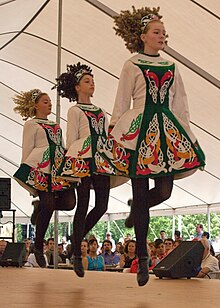
Back Irish dance BAR Irské tance Czech Irsk dans Danish Irish Dance German Danza irlandesa Spanish Irlandar dantzak Basque رقص ایرلندی Persian Irlantilainen tanssi Finnish Danse irlandaise French Damhsa Gaelach Irish
| Irish dance | |
|---|---|
 Most modern Irish dancers wear elaborate competition dresses, large wigs, and makeup for performance and competition purposes. | |
| Medium | Dance |
| Types | |
| Ancestor arts |
|
| Originating culture | Irish |
| Originating era | 18th century |
Irish dance refers to the traditional dance forms that originate in Ireland, including both solo and group dance forms, for social, competitive, and performance purposes. Irish dance has evolved over centuries and is believed to have its roots in ancient Celtic dance.[1] In the 17th and 18th centuries, dance was taught by "travelling dance masters" across Ireland, and separate dance forms developed according to regional practice and differing purposes. Irish dance became a significant part of Irish culture, particularly for Irish nationalist movements. From the early 20th century, a number of organisations promoted and codified the various forms of dance, creating competitive structures and standardised styles. Irish dancers who compete for competitive reasons dance in a dance style that is more modern than traditional Irish dance. It is mainly done solo, but there is some team dancing in groups of 2, 3, 4, 6, 8, 10, 16 and even numbers onwards.
Solo Irish dance includes the most well-known form of Irish dance, Irish stepdance, which was popularised from 1994 onwards by shows such as Riverdance, and which is practised competitively across not only the Irish diaspora but by many people of disparate cultural backgrounds. Stepdance is characterised by the rigid upper body and intricate footwork of its performers. Other forms of solo Irish dance include sean-nós dance, a relaxed and social dance style involving improvised steps, and festival Irish dance, a style which separated from step dance in the mid-20th century.
Irish group dancing has some French influences, and was particularly influenced by the French quadrille in the late 18th century.[2] Ceili dance, practised both competitively and socially, is performed by groups of two to sixteen people, and often uses traditional or codified dances and formations. Its footwork is simple, and emphasis is placed on the figures and formations of the dances. Set dance is primarily a social tradition, for groups of four dancers, and includes elements of the intricate footwork found in step dance.
- ^ "How Irish Dancing conquered the world". The Irish Post. 5 March 2022. Retrieved 25 August 2024.
- ^ "Irish Dance History". Irish Bliss. Retrieved 25 August 2024.
© MMXXIII Rich X Search. We shall prevail. All rights reserved. Rich X Search